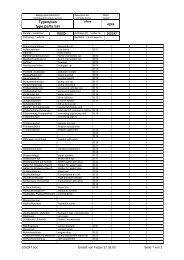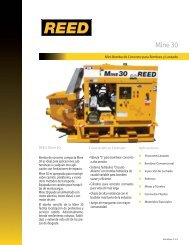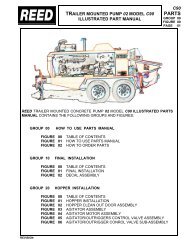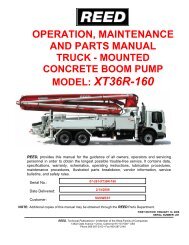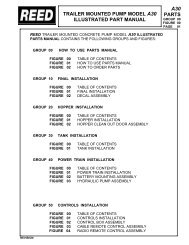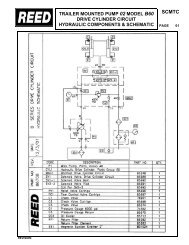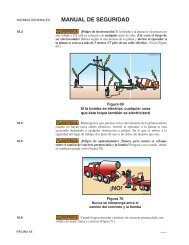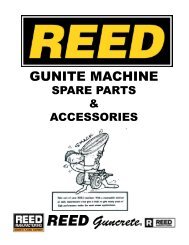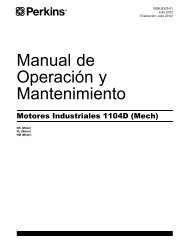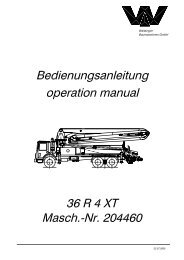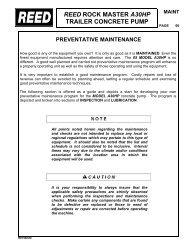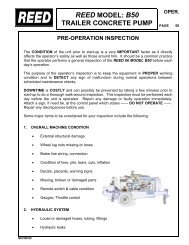Perkins Motor Operation and Maintenance Manual (English) - REED
Perkins Motor Operation and Maintenance Manual (English) - REED
Perkins Motor Operation and Maintenance Manual (English) - REED
You also want an ePaper? Increase the reach of your titles
YUMPU automatically turns print PDFs into web optimized ePapers that Google loves.
SEBU8325-01 73<br />
<strong>Maintenance</strong> Section<br />
Hoses <strong>and</strong> Clamps - Inspect/Replace<br />
If a bulk storage tank has been refilled or moved<br />
recently, allow adequate time for the sediment to<br />
settle before filling the engine fuel tank. Internal<br />
baffles in the bulk storage tank will also help trap<br />
sediment. Filtering fuel that is pumped from the<br />
storage tank helps to ensure the quality of the fuel.<br />
When possible, water separators should be used.<br />
Each installation application can be different. The<br />
differences depend on the following factors:<br />
• Type of hose<br />
• Type of fitting material<br />
• Anticipated expansion <strong>and</strong> contraction of the hose<br />
Hoses <strong>and</strong> Clamps -<br />
Inspect/Replace<br />
i02677365<br />
• Anticipated expansion <strong>and</strong> contraction of the<br />
fittings<br />
Replace the Hoses <strong>and</strong> the Clamps<br />
Inspect all hoses for leaks that are caused by the<br />
following conditions:<br />
• Cracking<br />
• Softness<br />
• Loose clamps<br />
Replace hoses that are cracked or soft. Tighten any<br />
loose clamps.<br />
NOTICE<br />
Do not bend or strike high pressure lines. Do not install<br />
bent or damaged lines, tubes or hoses. Repair<br />
any loose or damaged fuel <strong>and</strong> oil lines, tubes <strong>and</strong><br />
hoses. Leaks can cause fires. Inspect all lines, tubes<br />
<strong>and</strong> hoses carefully. Tighten all connections to the recommended<br />
torque.<br />
Check for the following conditions:<br />
• End fittings that are damaged or leaking<br />
• Outer covering that is chafed or cut<br />
• Exposed wire that is used for reinforcement<br />
• Outer covering that is ballooning locally<br />
• Flexible part of the hose that is kinked or crushed<br />
• Armoring that is embedded in the outer covering<br />
Aconstant torque hose clamp can be used in place<br />
of any st<strong>and</strong>ard hose clamp. Ensure that the constant<br />
torque hose clamp is the same size as the st<strong>and</strong>ard<br />
clamp.<br />
Due to extreme temperature changes, the hose will<br />
harden. Hardening of the hoses will cause hose<br />
clamps to loosen. This can result in leaks. A constant<br />
torque hose clamp will help to prevent loose hose<br />
clamps.<br />
Refer to the OEM information for further information<br />
on removing <strong>and</strong> replacing fuel hoses (if equipped).<br />
The coolant system <strong>and</strong> the hoses for the coolant<br />
system are not usually supplied by <strong>Perkins</strong>. The<br />
following text describes a typical method of replacing<br />
coolant hoses. Refer to the OEM information for<br />
further information on the coolant system <strong>and</strong> the<br />
hoses for the coolant system.<br />
Pressurized System: Hot coolant can cause serious<br />
burns. To open the cooling system filler cap,<br />
stop the engine <strong>and</strong> wait until the cooling system<br />
components are cool. Loosen the cooling system<br />
pressure cap slowly in order to relieve the pressure.<br />
1. Stop the engine. Allow the engine to cool.<br />
2. Loosen the cooling system filler cap slowly in<br />
order to relieve any pressure. Remove the cooling<br />
system filler cap.<br />
Note: Drain the coolant into a suitable, clean<br />
container. The coolant can be reused.<br />
3. Drain the coolant from the cooling system to a<br />
level that is below the hose that is being replaced.<br />
4. Removethehoseclamps.<br />
5. Disconnect the old hose.<br />
6. Replace the old hose with a new hose.<br />
7. Install the hose clamps with a torque wrench.<br />
Note: For the correct coolant, see this <strong>Operation</strong> <strong>and</strong><br />
<strong>Maintenance</strong> <strong>Manual</strong>, “Fluid Recommendations”.<br />
8. Refill the cooling system. Refer to the OEM<br />
information for further information on refilling the<br />
cooling system.



